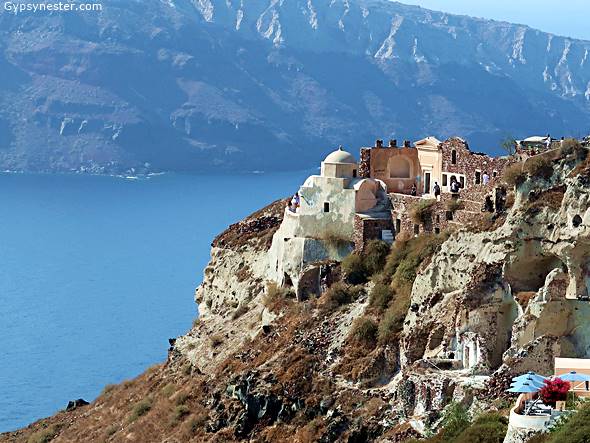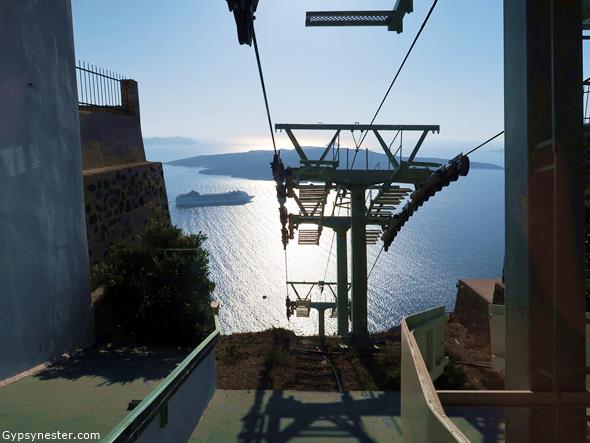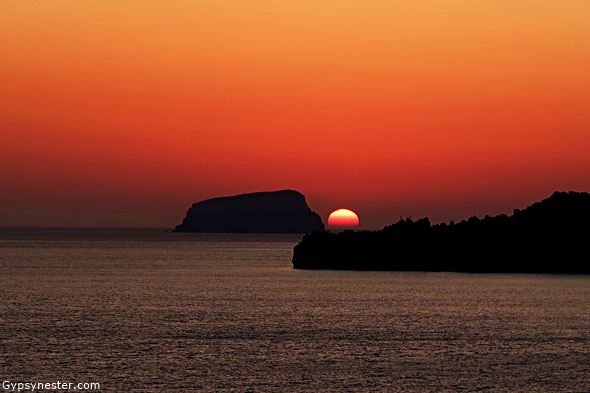
Santorini may well be the most famous of the Greek Isles. This is the home of the iconic whitewashed buildings and blue domed churches that we have seen gleaming in the sun against the backdrop of the deep blue Mediterranean Sea in every travelogue since we were kids.
And lucky for us, the day we visited was like stepping into a postcard. Perfect sunny weather greeted us as we tendered ashore from our ship, the Aegean Odyssey. Even the short ride to the dock was awe inspiring because the trip was made in the caldera of an active volcano.
 In fact, one of recorded history’s most violent volcanic eruptions created the unique crescent shape of the island when the bulk of the land here was blown away about four thousand years ago.
In fact, one of recorded history’s most violent volcanic eruptions created the unique crescent shape of the island when the bulk of the land here was blown away about four thousand years ago.
The explosion is thought to possibly be the inspiration for the legend of Atlantis and is also responsible for something about Santorini that we didn’t know until we arrived. An incredible archeological site, similar to Pompeii, was discovered when the town of Akrotiri was unearthed in the late eighteen hundreds.
 The entire city was buried under layers of volcanic ash, therefore being almost perfectly preserved and providing a remarkable glimpse into everyday life from sixteen centuries before Christ.
The entire city was buried under layers of volcanic ash, therefore being almost perfectly preserved and providing a remarkable glimpse into everyday life from sixteen centuries before Christ.
Even though extensive excavations began in 1967, as we walked through the mammoth structure built to protect the findings scientists continued to carefully extract more artifacts. This way we could observe not only the past results, but how new finds are currently being preserved.
With the ash removed we could easily recognize the rooms, including bedrooms, kitchens and bathrooms, along with beds, pottery, plumbing, and even artwork that have been uncovered nearly intact.

However, unlike its Italian counterpart, no people were caught up in the cataclysm, which leads researchers to surmise that they must have had some warning of the impending doom. Perhaps they had learned that earthquakes and smoke billowing from the summit were an indication of an imminent eruption and that evacuation was a very good idea.
The lack of victims frozen in time also led us to conclude that the overall experience was not nearly as disconcerting as when we visited Pompeii.
Still, it was something less than uplifting so we were ready for a bit of the scenery that has kept Santorini consistently named as one of the Top 20 Greek Islands.
So we made our way along the entire length of the island to the far northern tip and the town of Oia, home to all of those postcard pictures we were talking about.
 This village is perched precariously on the very tip of the crescent shaped remainder of the caldera’s rim, so the buildings are packed tightly against each other. The blindingly bright whitewash is only broken up by splashes of blue on the domes of the churches.
This village is perched precariously on the very tip of the crescent shaped remainder of the caldera’s rim, so the buildings are packed tightly against each other. The blindingly bright whitewash is only broken up by splashes of blue on the domes of the churches.
 Luckily, most of the roads within the town are closed to vehicles, but there was more than enough pedestrian traffic to make up for the loss.
Luckily, most of the roads within the town are closed to vehicles, but there was more than enough pedestrian traffic to make up for the loss.
After a few hours of wandering, and an ice cream to cool off, we were ready to make our way down the steep cliffs and back to our ship. Since this was not where we came ashore, we had to find a new way down to the sea.
This meant we needed to make our way toward the center of the isle and the current capital city, Firá. The name comes from the ancient name for the island, Thíra, being simply a variant of pronunciation.
 Being the capital, this is also home to the main cathedral, the Orthodox Metropolitan Cathedral. What the church lacks in name originality, it more than makes up for in unique whitewashed beauty.
Being the capital, this is also home to the main cathedral, the Orthodox Metropolitan Cathedral. What the church lacks in name originality, it more than makes up for in unique whitewashed beauty.
So we lingered a while and moseyed around the myriad of shops along the tiny pathways nearby.
But we didn’t want to get left behind when the ship sailed, so we needed to hustle down to the docks. Unlike coming ashore in the morning, there is no road here.
 For years, maybe centuries, donkeys carried folks up and down, but now there is a new cable car system to ferry us to the dock below. There are still donkeys available, but locals tend to frown on using them anymore and no doubt their backs are thankful for the new found lack of customers.
For years, maybe centuries, donkeys carried folks up and down, but now there is a new cable car system to ferry us to the dock below. There are still donkeys available, but locals tend to frown on using them anymore and no doubt their backs are thankful for the new found lack of customers.
Back onboard, the crew of the Aegean Odyssey knew that Santorini is also famous for one more thing, some of the world’s most vivid sunsets.
 As our day came to a close the volcanic dust that still lingers in the air filtered the fading light into a masterpiece of colors across the western horizon while the disk of the sun settled into the sea.
As our day came to a close the volcanic dust that still lingers in the air filtered the fading light into a masterpiece of colors across the western horizon while the disk of the sun settled into the sea.
It seemed only right to offer a toast to Helios and Apollo while we watched from the deck above the pool.
David & Veronica, GypsyNester.com
See all of our previous adventures in Greece!
Thanks to Road Scholar for providing this lifelong learning adventure through the Greek Isles! As always, all opinions are our own.



We loved Santorini. Did the Oia sunset from the land and from the water, where we sailed through serenaded by a saxophonist. Most fun was hiring a quad bike and checking out the cave restaurants near the ruins at Akrotiri.
It is great. Would have loved to rent bikes. Happy & safe travels.